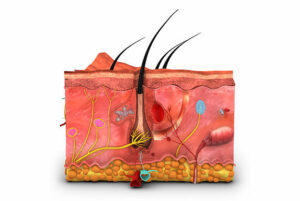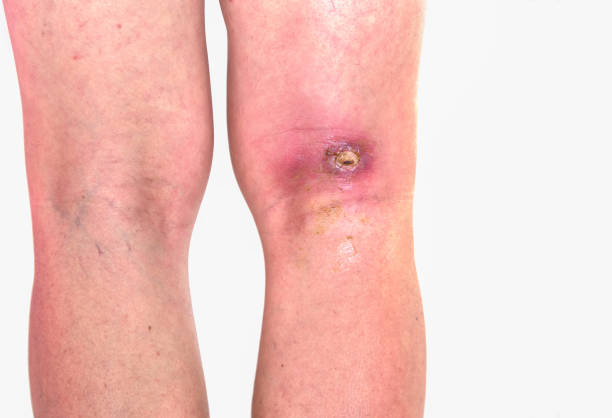Skin ulcers are a lot more popular than most people think. In this post, we will cover all things skin ulcers. You may just have to pay a quick visit to your doctor after reading this.
The skin is the largest organ in the body. It is the covering of the body’s surface that protects it from microbes and the elements, helps regulate body temperature, and receives sensory stimuli from the external environment (permits the sensations of touch, heat, and cold).

The skin has three layers:
- The epidermis is the outermost layer of skin. It contains the primary protective structure, the stratum corneum, which provides a waterproof barrier and creates our skin tone.
- The dermis is the fibrous layer beneath the epidermis that supports and strengthens it. It contains tough connective tissue, hair follicles, and sweat glands.
- The deeper subcutaneous tissue (hypodermis) beneath the dermis. It is made of fat and connective tissue and supplies nutrients to the other two layers that cushion and insulates the body.
The skin can suffer several conditions that can cause pain and discomfort. These include:
- Rash
- Dermatitis
- Eczema
- Psoriasis
- Dandruff
- Acne
- Cellulitis
- Skin abscess
- Rosacea
- Warts
- Melanoma
- Basal cell carcinoma
- Seborrheic keratosis
- Actinic keratosis
- Squamous cell carcinoma
- Herpes
- Hives
- Tinea versicolor
- Viral exanthem
- Shingles
- Scabies
- Ringworm
Besides all these, however, the skin can suffer a condition called skin ulcers.
What is an Ulcer?
Ulcers are sores that are slow to heal or keep returning. They can take many forms and can appear both on the inside and the outside of the human body.
Ulcers can be found on the parts of the body that are visible to the human eyes, such as a leg ulcer found on the skin, or in parts of the body that we can’t see, such as a peptic ulcer in the lining of the stomach or upper intestine. Ulcers can appear anywhere on the human body.
What is a skin ulcer?
A skin ulcer is an open wound that develops on the skin as a result of injury, trauma, long-term pressure or poor circulation.
How do Skin Ulcers form?
If you have an injury, good blood flow is necessary for the wound to heal. But if you have problems with blood circulation, minor injuries can’t heal properly. Over time, these injuries become ulcers. The wound is roughly circular and the centre is open and raw. With skin ulcers, there is a break in the skin, through which the underlying tissues can be seen.
Skin ulcers can form on any area of the skin. Depending on the type, they are especially common on the legs, mouth or lips, hips, and buttocks. The most popular, however, are the legs. Skin ulcers are more common in older people. Skin ulcers often become infected if not properly treated. If the infection is left untreated it can spread to deeper tissue, bones, joints, and blood resulting in a very serious issue that can require immediate medical attention.
Did you know? Generally, skin ulcer recovery occurs within a few weeks to three months. Serious ulcers can take up to two years.
Types of Skin Ulcers
Skin ulcers are classified based on the cause. As stated above, the major causes of skin ulcers are poor blood circulation, pressure and trauma.
- Venous ulcers. These ulcers occur when there is poor circulation in the legs. When there is damage to the valves inside leg veins, it prevents blood from returning to the heart. Instead, blood collects in the lower legs, causing them to swell. This swelling puts pressure on the skin, which can cause ulcers.
This type of ulcer is more common in people with varicose veins that have led to associated skin problems such as varicose eczema. They are also more common in overweight or obese people or people who are not very mobile. Pregnancy can also put one at a higher risk of developing these ulcers. They can also occur when the circulation is damaged by a deep vein thrombosis (DVT).
Venous skin ulcers are the most common type of skin ulcer. Roughly 80-90% of all leg ulcers are venous leg ulcers. This type of ulcer usually affects the leg between the ankle and knee.
- Arterial Skin Ulcers: Arterial ulcers, also known as “ischemic ulcers”, occur when Atherosclerosis results in poor blood flow as a result of blocked arteries. In order words, arterial skin ulcers can develop when arteries aren’t delivering blood to the skin properly.
Any condition that compromises the body’s blood circulation makes it more likely to develop arterial skin ulcers. This specific type of skin ulcer is known to cause extreme pain, and can worsen at night or when the affected person is immobile. Arterial skin ulcers are commonly found in the lower leg, feet, toes, heels, the outer side of the ankles etc.
- Decubitus (pressure) ulcers: These types of skin ulcers are caused by the continuous application of pressure or friction on the skin. They’re also called pressure ulcers or pressure sores. These ulcers often develop on bony areas, because the bones place extra pressure on the skin. Decubitus skin ulcers typically affect the back, hips, buttocks, ankles and heels.
- Neuropathic Skin Ulcers: Neuropathic ulcers are predominant among people who are highly diabetic. They’re also called diabetic foot ulcers. Neuropathic foot ulcers affect about 15 per cent of people with diabetes.
Neuropathic ulcers are usually caused by nerve damage or narrow arteries. Note that since neuropathic ulcers are also referred to as “diabetic foot ulcers”, it usually affects the heels, toes and bottom of the feet. These types of skin ulcers occur due to damaged nerves resulting in numbness or a loss of sensation in parts of the feet.
How are Neuropathic skin ulcers formed?
Some injuries to the skin occur because there is a problem with the feeling (sensation) in the skin. If you can’t feel your feet, for example, you may not be able to tell that a shoe is too tight, or the bath is too hot. So you end up with a blister or a burn. In general, you won’t feel when your feet are tired and need a rest, or if there are small injuries that need to be addressed.
Coupled with compromised circulation, these wounds aren’t able to heal and, over time, a neuropathic ulcer develops. These ulcers typically develop on the pressure points of the foot. Neuropathic skin ulcers are a common complication of uncontrolled diabetes. Over time, elevated blood glucose levels can cause nerve damage, which results in a reduced or total loss of feeling in the hands and feet. This condition occurs in approximately 60-70 per cent of people with diabetes.
One of the most dangerous aspects of these types of skin ulcers is that because of the loss of feeling in the foot, these ulcers may not hurt, so they are easy to ignore.
Neuropathic skin ulcers develop from smaller wounds, such as blisters or small cuts. A person with diabetes-associated neuropathy might not realize that they have an ulcer until it starts leaking fluid or becomes infected, in which case they may notice a distinct odour.
- Buruli ulcer: Buruli ulcer is a medical condition caused by the bacteria Mycobacterium ulcerans. An infection with this bacteria can lead to ulcers in the arms and legs. Buruli ulcers require immediate medical attention. If left untreated, Buruli ulcers can result in permanent physical damage and disability.
- Stasis Dermatitis: This type of skin ulcer usually develops on the legs, causing skin irritation and inflammation. It occurs when the legs are deprived of proper blood circulation, resulting in fluid buildup. Stasis dermatitis is dominant among women who are over the age of 50.

Stages of Skin Ulcers
Over time, skin ulcers undergo various changes. Recognizing what stage your skin ulcer is in, can help you to treat it better.
- First Stage: You may notice redness in your skin and the underlying tissues.
- Second Stage: The redness becomes visible. The patient may also experience swelling, blisters, and cracks around the affected areas of the skin.
- Third Stage: Here, the skin becomes necrotic. This means that the skin and the nearby tissues die due to poor blood circulation to the affected areas. It spreads deep into the skin, making the fat under the skin visible.
- Final Stage: In this final stage, the necrosis becomes deeper; completely exposing the fat under the skin and muscles. The infected sores may result in muscle necrosis. In extreme cases, it may affect the bones and even cause joint sepsis.
Symptoms and Diagnosis of Skin Ulcers
Skin ulcers typically look like a round open sore in the skin. They begin with redness, swelling, and tenderness around the skin. The outer border of the sore might look raised and thick. Some ulcers may feel painful and have a buildup of fluids in the sores. As the ulcer forms, you may notice skin discolouration in that specific area. These may also cause bleeding of the skin and in rare cases, you may have a fever.
Skin ulcers can cause:
- Deviation from normal skin structure and texture
- Discoloured skin
- Skin irritation
- Pain
- Bleeding
- Discharge
- Foul smell in the affected area
- Itch
- Yellow or green pus (due to an infection)
Diagnosis
A healthcare provider can generally diagnose a skin ulcer by simply looking at it. In some cases, the doctor can perform different tests to diagnose skin ulcers. This might include:
- Medical history. This information can help your doctor better understand your symptoms.
- Physical exam. The doctor will examine the size and depth of the sore, and look for blood, fluid, or pus.
- Blood test. If the ulcer is infected, a blood panel will show how your body is fighting the infection. A blood test can also show underlying problems.
- Tissue or fluid culture. This test can determine what kind of bacteria is causing the infection. This is very important, to prescribe the right antibiotics.
- Imaging tests, for example, an X-ray, CT scan, or MRI. These help the doctor look at the tissue and bone under the sore.
Treatment for Skin ulcers
The goal of skin ulcer treatment is to heal the wound, reduce pain, and treat any infection. Treatment may include:
- Dressing to protect the wound and keep it clean. This promotes healing and prevents infection.
- Antibiotics ointment, if the ulcer is infected. However, If the infection has reached deeper tissue or bone, the patient will require oral antibiotics. Antibiotics may also be prescribed to reduce the risk of infection.
- Pain medication
- Surgery
- If other treatments don’t work, or if there is a large sore, a skin graft may be performed. This will close the wound and help with proper healing.
Conclusion:
A skin ulcer is an open wound that develops on the skin as a result of injury, trauma, long-term pressure or poor circulation. Skin ulcers often become infected if not properly treated. If the infection is left untreated it can spread to deeper tissue, bones, joints, and blood resulting in a very serious issue that can require immediate medical attention. If you suspect that you have a skin ulcer, visit your doctor immediately for proper diagnosis and treatment.



